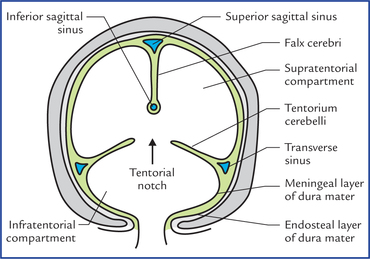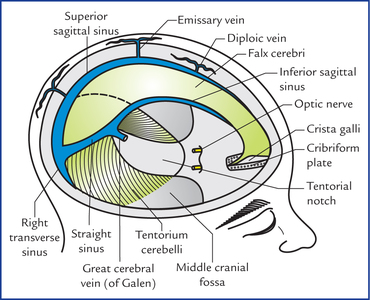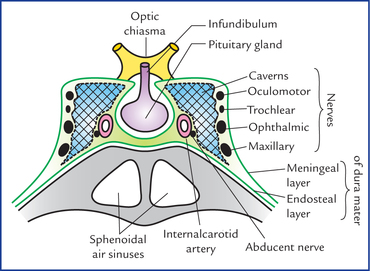16 The brain and spinal cord are enclosed in three protective membranes called meninges. From without inwards these are: (a) dura mater, (b) arachnoid mater, and (c) pia mater. The arachnoid mater and pia mater together are termed leptomeninges (Gk. lepto = thin). The spinal meninges are described in Chapter 7). Fig. 16.2 Schematic coronal section of skull showing division of cranial cavity into three compartments by falx cerebri and tentorium cerebelli. Each half of the supratentorial compartment contains the cerebral hemisphere, whereas the infratentorial compartment contains the cerebellum and brainstem. The four important dural septa are: It has two borders: (a) an outer convex attached border, and (b) an inner concave free border. The inner border bounds an oval space, the tentorial notch or the door of tentorium through which passes the midbrain to connect the hindbrain with the forebrain (Fig. 16.2). Tentorium cerebelli contains four dural venous sinuses, two on either side: The nerve supply of dura mater is derived mainly from three sources: • The supratentorial dura is supplied by the meningeal branches from the three divisions of the trigeminal nerve: 1. In the anterior cranial fossa by meningeal branches of the anterior and posterior ethmoidal nerves. 2. In the middle cranial fossa by meningeal branches of maxillary and mandibular nerves. • The infratentorial dura is supplied by ascending meningeal branches of upper three cervical nerves. The dural venous sinuses are formed in following two ways: (a) by separation of the two layers of cerebral dura, and (b) by reduplication of the meningeal layer of dura (Fig. 16.2). • Have no valves, hence the blood can flow in either direction in the sinuses, • Are devoid of smooth muscle fibres in their walls, • Drain finally into the internal jugular veins, • Have cerebral, diploic and some meningeal veins as their tributaries, • Communicate via valveless emissary veins with the extracranial veins through skull foramina. The dural venous sinuses are classified into two types, unpaired and paired (Table 16.1). Table 16.1 Classification of dural venous sinuses The shapes of various dural folds, and sinuses enclosed in them are summarized in Table 16.2. Table 16.2 Shapes of dural folds and enclosed venous sinuses Sphenoparietal sinuses (Fig. 16.4) These small sinuses lie along the lesser wing of sphenoid and drain into the cavernous sinus. Cavernous sinuses (Figs 16.3, 16.4) Cavernous sinuses are situated one on either side of the sella turcica and, the body of sphenoid. Each sinus is a short wide venous channel measuring 2 cm anteroposteriorly and 1 cm transversely. It extends from superior orbital fissure anteriorly to the apex of petrous temporal bone posteriorly. The cavernous sinus is so named because it is traversed by a network of trabeculae which subdivide the cavity into numerous communicating caverns lined by endothelium. The two sinuses communicate with each other through anterior and posterior inter-cavernous sinuses which lie in the anterior and posterior margins of the diaphragma sellae, and pass anterior and posterior to the stalk of the pituitary gland respectively.
Meninges And Cerebrospinal Fluid
Meninges
Intracranial Meninges
Dura mater
Dura! septa or folds (Figs 16.1, 16.2)

Tentorium cerebelli
Nerve supply of dura mater
Dural venous sinuses
Unpaired
Paired
• Superior sagittal sinus
• Sphenoparietal sinuses
• Inferior sagittal sinus
• Cavernous sinuses
• Straight sinus
• Superior petrosal sinuses
• Occipital sinus
• Inferior petrosal sinuses
• Anterior intercavernous sinus
• Transverse sinuses
• Posterior intercavernous sinus
• Sigmoid sinuses
Unpaired sinuses
Fold
Shape
Venous sinuses enclosed
Falx cerebri
Sickle-shaped
Superior sagittal, inferior sagittal and straight sinuses
Tentorium cerebelli
Tent-shaped (semilunar)
Transverse and superior petrosal sinuses
Falx cerebelli
Sickle-shaped
Occipital sinus
Diaphragma sellae
Horizontal fold
Anterior and posterior intercavernous sinuses
Paired sinuses
![]()
Stay updated, free articles. Join our Telegram channel

Full access? Get Clinical Tree










